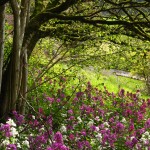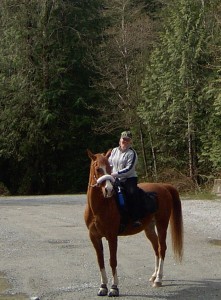Understanding and Growing Herbs for Horses
When I first studied Herbal medicine, (having come from an Engineering and Science background) I had great difficulty coming to terms with, and understanding how on earth all this knowledge was arrived at in the first place.
How many dead Herbalists did it take to decide which herbs were poisonous? And then -How many more trials did it take to find out that Dandelion was good to treat Liver conditions?
It seemed impossible to me that such detailed knowledge could first be acquired, and then retained and shared by all the different cultures on earth. All I knew was that they had much more time on their hands in ancient times and certainly lived with, and observed nature much more closely than we do. Nowadays we spend much of our outdoor time in our cars watching nature flashing by through the glass or plugging a I-pod into our head while jogging in the streets.
How many people do you know that would even get close to two weeks a year camping out in open country in a tent under the stars?
It was only after beginning to treat animals, that I really began to see how it worked. My logic and my reason could cope with the idea that Stock Herders who, had no fences, and who spent their lives watching and worrying about their animals, would have had ample time to watch the animals seeking out herbs and weeds in their pasture at different times. Then, for these herders to connect with the idea that the choice of particular herbs related to health or injury or seasonal or reproductive demands on the animal. The animals already “knew” what they needed, it was built into their instincts.
All of you horse owners and trainers have experienced your animals pulling towards different weeds along the side of the road or eating their faeces, or turning up their nose at something you offer them, or sampling all sorts of things if they happen to get into the Vegetable Garden! We all know about dogs eating grass when they are ill.
We are animals! We all knew for ourselves! Nature also helped by colour coding plants for us with poisonous berries often being black, or smelling foul, or tasting bad, and others attracting us by their appearance or their taste. We all know about pregnant ladies cravings. I remember driving around London at 10pm looking for a Vegetable Store which was open because my wife “HAD TO HAVE CAULIFLOWER CHEESE !!!” and this was not just once, it was 5 or 6 times, during her first pregnancy.
We always knew, and mostly we have forgotten. However, those of each generation who took a special interest, listened, collected, accumulated, experimented and practiced with this knowledge. They became the “Practitioners” of each generation, but every mother knew all the basics.
Of course, this is all blindingly obvious to most intuitive and open minded people, but you must remember that I am a male and I came from a scientific background, which made it a much slower and more painful experience to accept and to understand that we are much more stupid in our “civilized” state than we ever were before.
Hawthorn Bushes and Field Stones have always been the favourite fencing material in Western Europe and are usually found together. Stones are not all that nutritious, but an extract of Hawthorn Berry is a major first aid treatment for severe injury or illness.
Hawthorn is a heart tonic and the berries in their fresh or dried state hang about on trees pretty well all year round so they are there if we need them. I make an extract by soaking dried berries in Organic Cider Vinegar and by adding a few drops of Rescue Remedy I then have a first aid shock treatment. If you happen to have some on hand, and you suspect your husband is having a heart attack, give him some, (even a few drops), take some yourself, and then, call the ambulance, (in that order)
Hawthorn Hedges (called “Ditches” in Ireland) are an ideal breeding ground for weeds, they protect the weeds from being grazed to the ground but make them available as required. It is a very simple matter to grow short sections of hedges at the intersection of paddocks, as wind breaks and shelters or as privacy hedges and to seed herbs within them.
One of you out there could even market packages of all the appropriate seeds so we could just sprinkle them along the line of the young bushes, protect the whole lot for a couple of seasons with an electric fence and there you have it. Your “Hedgerow Mix” should include but not be limited to the following.
Aniseed, Borage, Comfrey, Chicory, Dandelion, Dill, Fennel, Garlic, Horehound, Horse Radish, Horsetail, Mint, Nettle, Rosehips, Rosemary, Rue, Sage, Tansy, Vervain, Wild Oat, Wormwood, Yarrow
Your Hedgerow now becomes not only the place where your horse can self medicate but the place where you can collect herbs for drying and preparation and for making up particular brews. When selecting the individual herbs you want the wild varieties, not the modern commercial ones. That is to say, find some of the old fashioned garlic with the small cloves, make sure you get the Wild or Dog Rose (your pastures protection authority will be able to help you here).
Robert McDowell & Dianne Rowling’s comprehensive book called ‘Herbal Horsekeeping’ , available in book stores and on Amazon.com. I personally own this book and have found it to be incredibily useful. It is definately a worthwhile addition to your horsebook library! Click here for the Amazon link to Herbal Horsekeeping.




